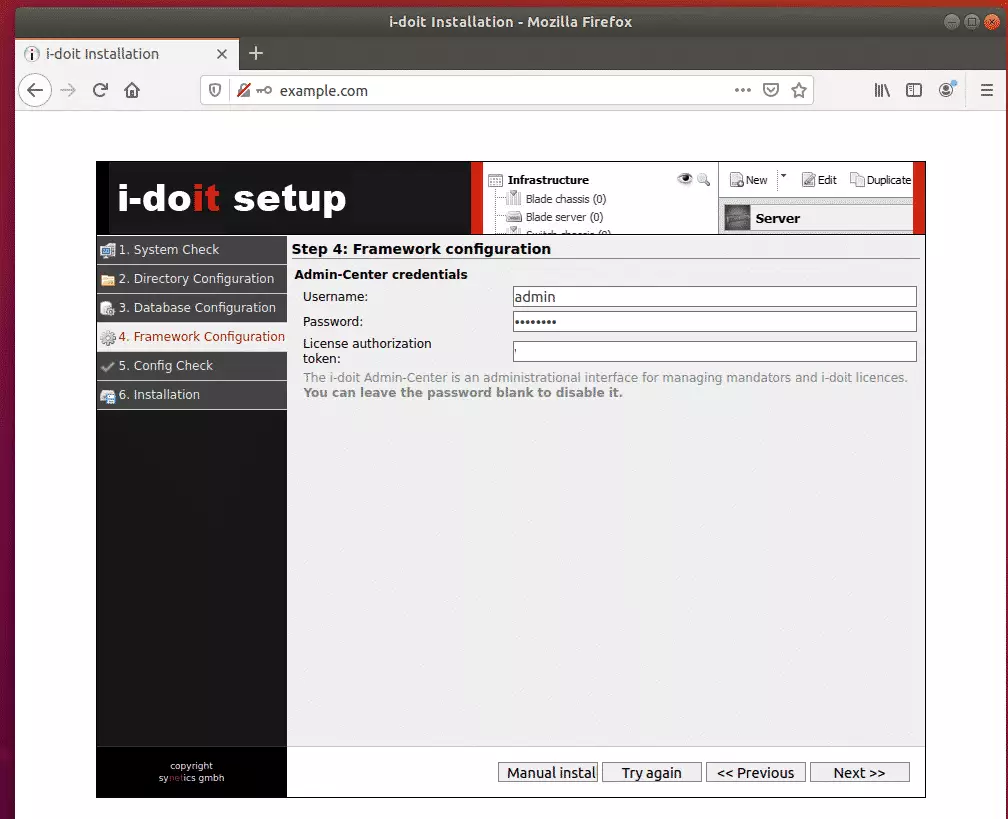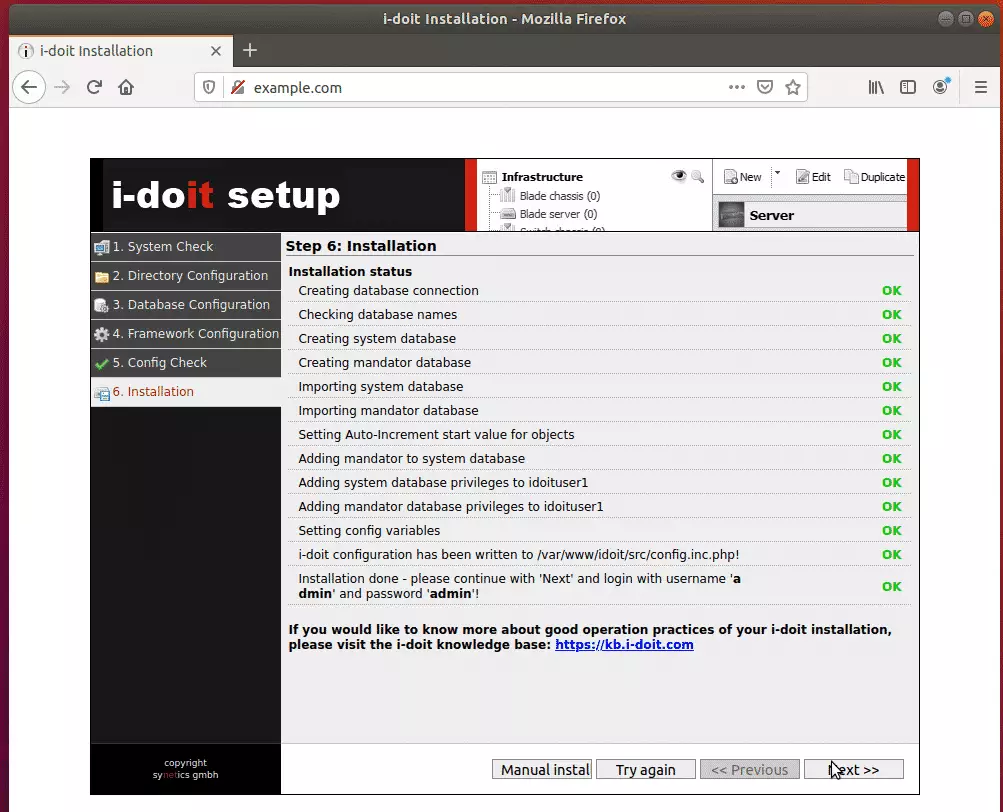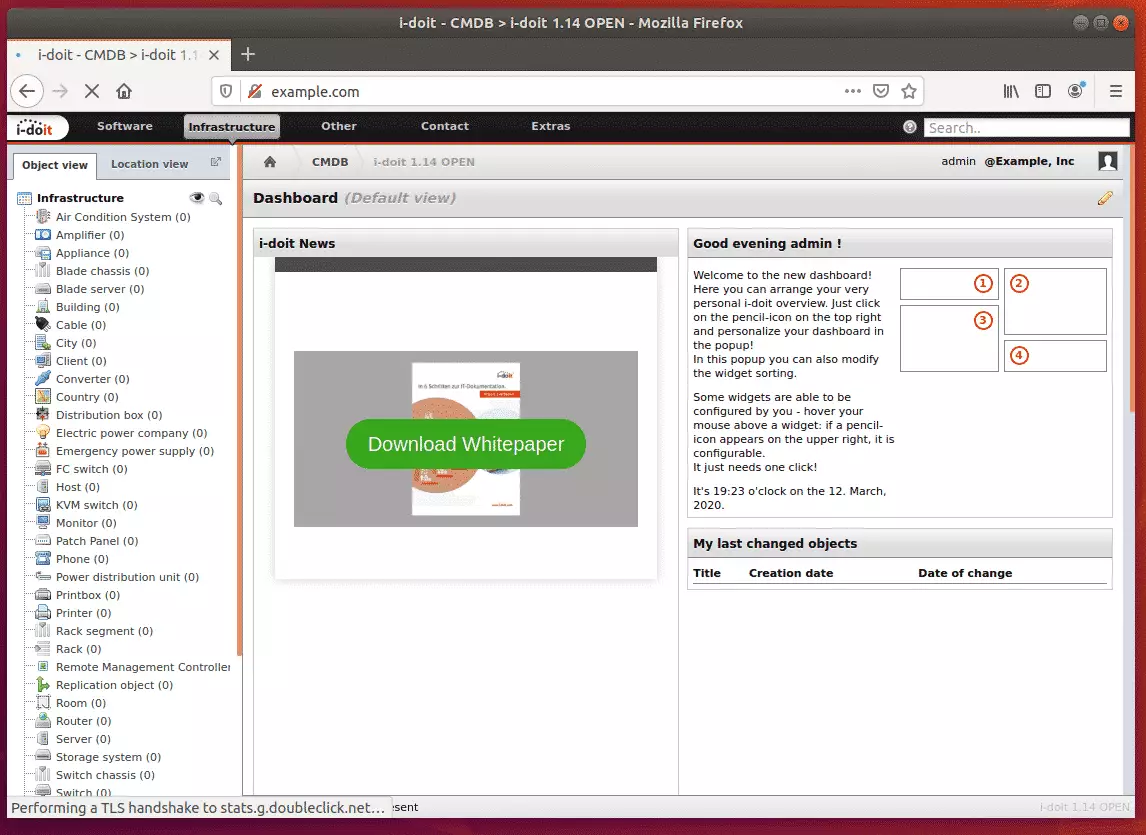This brief tutorial shows students and new users how to install the i-doit documentation platform on Ubuntu 18.04 | 16.04 with an Apache2 HTTP server.
I-doit is a free, open-source knowledge base and documentation software built with PHP.
With i-doit, companies and individuals can provide solutions tailored to their documentation needs. It can also be a wiki, knowledge base, and other functions.
Whether creating a personal or company documentation or knowledge base platform, i-doit can help you build a robust platform that works across every device with its intuitive and powerful user and admin dashboard.
For more on i-do it, please visit its home page
To get started with installing i-do, follow the steps below:
Install Apache2 HTTP
Apache2 HTTP Server is the most popular web server. Install it since i-doit needs it.
To install Apache2 HTTP on the Ubuntu server, run the commands below.
sudo apt update sudo apt install apache2
After installing Apache2, the commands below can be used to stop, start, and enable the Apache2 service to always start up with the server boots.
sudo systemctl stop apache2.service sudo systemctl start apache2.service sudo systemctl enable apache2.service
To determine if the Apache2 HTTP server is installed, simply open your web browser and type in the server’s IP or hostname.
When you see a page similar to the one below, Apache2 is installed and working.
http://localhost

Install MariaDB Database Server
i-doit also needs a database server to store its content. MariaDB database server is a great place to start when looking at open-source database servers to use with i-doit.
To install MariaDB run the commands below.
sudo apt install mariadb-server mariadb-client
After installing MariaDB, the commands below can stop, start and enable the MariaDB service to start up when the server boots.
Run these on Ubuntu
sudo systemctl stop mariadb.service sudo systemctl start mariadb.service sudo systemctl enable mariadb.service
After that, run the commands below to secure the MariaDB server by creating a root password and disallowing remote root access.
sudo mysql_secure_installation
When prompted, answer the questions below by following the guide.
- Enter current password for root (enter for none): Press the Enter
- Set root password? [Y/n]: Y
- New password: Enter password
- Re-enter new password: Repeat password
- Remove anonymous users? [Y/n]: Y
- Disallow root login remotely? [Y/n]: Y
- Remove test database and access to it? [Y/n]: Y
- Reload privilege tables now? [Y/n]: Y
Restart MariaDB server
To test if MariaDB is installed, type the commands below to log into the MariaDB server.
sudo mysql -u root -p
Then type the password you created above to sign on. If successful, you should see MariaDB welcome message.
Install PHP 7.2 and Related Modules
PHP 7.2 may not be available in Ubuntu default repositories. To install it, you will have to get it from third-party repositories.
Run the commands below to add the below third party repository to upgrade to PHP 7.2
sudo apt-get install software-properties-common sudo add-apt-repository ppa:ondrej/php
Then update and upgrade to PHP 7.2
sudo apt update
Next, run the commands below to install PHP 7.2 and related modules.
sudo apt install php7.2 libapache2-mod-php7.2 php7.2-common php7.2-gmp php7.2-curl php7.2-intl php7.2-mbstring php7.2-xmlrpc php7.2-mysql php7.2-gd php7.2-bcmath php7.2-xml php7.2-cli php7.2-zip php7.2-sqlite3
After installing PHP 7.2, run the commands below to open the PHP default config file for Apache2.
sudo nano /etc/php/7.2/apache2/php.ini
Then save the changes on the following lines below in the file. The value below is an ideal setting to apply in your environment.
file_uploads = On allow_url_fopen = On short_open_tag = On memory_limit = 256M upload_max_filesize = 100M max_execution_time = 360 post_max_size = 128M max_input_vars = 10000 default_charset = "UTF-8" date.timezone = America/Chicago
After making the change above, please save the file and close it.
To test PHP 7.2 settings with Apache2, create a phpinfo.php file in the Apache2 root directory by running the commands below
sudo nano /var/www/html/phpinfo.php
Then type the content below and save the file.
<?php phpinfo( ); ?>
Save the file. Then browse to your server hostname followed by /phpinfo.php
http://localhost/phpinfo.php
You should see the PHP default test page.

Setup Root to Use Nave Password
Now that you’ve installed all the required packages continue below to start configuring the servers.
MariaDB is configured to use the UNIX auth_socket plugin by default on Ubuntu. You’ll want to run the SQL commands below for the root user to use mysql_native_password.
You’ll need a MariaDB root account to set up i-do it later.
Run the commands below to log on to MariaDB. When prompted for a password, type the root password you created above.
sudo mysql -u root -p
Switch to the MySQL database.
use mysql;
Then update the root account to use mysql_native_password.
UPDATE mysql.user SET plugin = 'mysql_native_password' WHERE User = 'root';
Finally, save your changes and exit.
FLUSH PRIVILEGES; EXIT;
Download i-doit Latest Release.
To get i-doit latest release, you may want to get it from its download page. The link below gets you there.
https://sourceforge.net/projects/i-doit/?source=directory
Use the commands below to download and install
sudo apt install wget cd /tmp wget https://downloads.sourceforge.net/project/i-doit/i-doit/1.14/idoit-open-1.14.zip sudo mkdir /var/www/idoit sudo unzip idoit-open-1.14.zip -d /var/www/idoit
Since you just ran the web server as root, you should ensure the www-data user and group own any newly created files.
To do that, run the commands below:
sudo chown -R www-data:www-data /var/www/idoit/ sudo chmod -R 755 /var/www/idoit/
Configure Apache
Finally, configure the Apahce2 site configuration file for i-doit. This file will control how users access i-doit content. Run the commands below to create a new configuration file called idoit.conf.
sudo nano /etc/apache2/sites-available/idoit.conf
Then copy and paste the content below into the file and save it. Replace the highlighted line with your domain name and directory root location.
<VirtualHost *:80>
ServerAdmin [email protected]
DocumentRoot /var/www/idoit
ServerName example.com
ServerAlias www.example.com
<Directory /var/www/idoit/>
Options +FollowSymlinks
AllowOverride All
Require all granted
</Directory>
ErrorLog ${APACHE_LOG_DIR}/error.log
CustomLog ${APACHE_LOG_DIR}/access.log combined
</VirtualHost>
Save the file and exit.
Enable the i-doit and Rewrite Module.
After configuring the VirtualHost above, please enable it by running the commands below.
sudo a2ensite idoit.conf sudo a2enmod rewrite sudo systemctl restart apache2.service
Then open your browser and browse to the server domain name or hostname. This is often localhost but can be a hostname or IP address. Your server admin or hosting company will have this information available.
http://example.com/
Continue with the installation wizard, validate that all requirements are met, and continue.

Next, accept the default directory paths and continue.

Type in the database configuration page the root password created above. Then create a new i-doit database username and password. When you’re done, click Next to continue.

Create an admin account and password.

After a brief moment, i-doit should be installed and ready to use.

Enjoy!

Conclusion:
You have learned to install i-doit on Ubuntu with an Apache2 HTTP server. If you find any errors above, please leave a comment below.
Thanks,

Leave a Reply